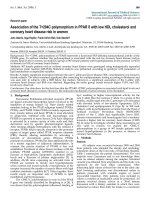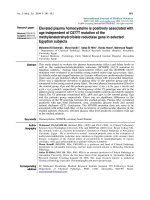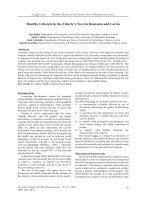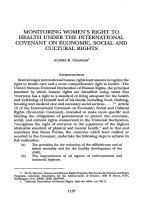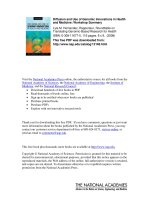Accelerating Equitable Achievement of the MDGs Closing Gaps in Health and Nutrition Outcomes potx
Bạn đang xem bản rút gọn của tài liệu. Xem và tải ngay bản đầy đủ của tài liệu tại đây (4.54 MB, 120 trang )
Accelerating Equitable Achievement of the MDGs
Closing Gaps in Health and Nutrition Outcomes
Contents
Foreword vii
Acknowledgements viii
Abbreviations ix
OVERVIEW
Accelerating Equitable Achievement of the MDGs: 1
Closing Gaps in Health and Nutrition Outcomes
Diagnosing disparities 1
Disparitiesbetweencountries 1
Disparitieswithincountries 2
Closing the health gaps 3
1. Addressthesocialdeterminantsof health 3
2. Expandaccesstoprimaryhealthcare 3
3. Integratechildandmaternalhealthintoacontinuumofcare 3
4. Actonthehealthneedsoftheurbanpoor 4
5. Devisesustainablefinancialstrategies 4
6. Improvethegovernanceof healthsystems 4
7. Enhancetheaffordabilityof medicinesthroughgenerics 4
8. Strengtheninternationalpartnershipandregionalcooperation 5
Mutual inspiration 5
CHAPTER I
MDGs in Asia and the Pacific: where we stand 7
Asia and the Pacific on the global stage 12
Health – diagnosing the deficits 12
Feedingourchildren 12
Preventingchilddeaths 12
Preventingmaternaldeaths 15
Providingsafedrinkingwater 23
Ensuringaccesstobasicsanitation 23
Number of people in off-track countries who will gain 27
if targets are reached
Chapter I Endnote 28
CHAPTER II
Diagnosing disparities 29
The extent of disparities 30
Measuring disparities between countries and over time 30
Why some countries do better than others in health 35
Economicgrowth 36
Healthexpenditure 36
Bettergovernance 36
Numberofhealthpersonnel 36
Genderequalityandwomen’sdevelopment 38
Infrastructure 38
Childimmunization 40
Sanitationandwatersupplies 40
Populationgrowth 40
Literacy 40
Accounting for disparities 40
Disparities within countries 41
Raisingtheattainmentlevelswhilereducingdisparities 45
Explaining disparities within countries 46
Urban-ruralgaps 49
Caste,ethnicityandlanguagegroup 53
Theimportanceof economicstatus 53
Regionaldifferencesinpoliciesandprogrammes 53
Mining the data 55
Chapter II Endnotes 55
CHAPTER III
Closing the health gaps 57
1. Addressthesocialdeterminantsof health 57
2. Expandaccesstoprimaryhealthcare 59
3. Integratechildandmaternalhealthintoacontinuumofcare 61
4. Actonthehealthneedsoftheurbanpoor 62
5. Devisesustainablefinancialstrategies 63
6. Improvethegovernanceof healthsystems 69
7. Enhancetheaffordabilityof medicinesthroughgenerics 70
8. Strengtheninternationalpartnershipandregionalcooperation 71
Mutual inspiration 72
Chapter III Endnotes 73
CHAPTER IV
Way Forward 75
MDGs Beyond 2015 76
Chapter IV Endnotes 77
BIBLIOGRAPHY 78
STATISTICAL APPENDIX 00
Technical Note 1: MDG progress classification 81
Technical Note 2: Factors explaining disparities between 85
countries
Technical Note 3: Accounting for disparities between 88
countries
Technical Note 4: Analysis of disparities within countries 90
Technical Note 5: Selected MDG Indicators 97
BOXES
BoxI-1 Ensuringcomparabledata 8
BoxI-2 DataonHIV 10
BoxI-3 Reproductivehealth 28
BoxIII-1 UnlikelyalliancesforreducingHIV-relatedstigma 58
BoxIII-2 PrimaryhealthcareinChina 59
BoxIII-3 Expenditureonpreventiveandpublichealth 60
BoxIII-4 NewfacilitiesreduceinfantmortalityinBihar,India 60
BoxIII-5 Mongolia’ssuccessinreducingmaternalmortality 63
BoxIII-6 Totalhealthexpendituresasashareof grossdomesticproduct 64
BoxIII-7 Out-of-pocketexpensesasashareof privatehealthexpenditures 65
BoxIII-8 Healthexpendituregaps 68
BoxIII-9 MarginalbudgetingforbottlenecksinPakistan 69
TABLES
TableI-1 Countrygroupsonandoff trackfortheMDGs 9
TableI-2 Countriesonandoff trackfortheMDGs 11
TableI-3 Rateof progressneededforoff-trackcountriestomeet 15
thechildnutritiontarget
TableI-4 Rateof progressneededforoff-trackcountriestomeet 17
theunder-5mortalitytarget
TableI-5 Rateof progressneededforoff-trackcountriestomeet 19
thematernalmortalitytarget
TableI-6 Rateof progressneededforoff-trackcountriestomeet 21
theskilledbirthattendancetarget
TableI-7 Rateof progressneededforoff-trackcountriestomeet 22
theantenatalcaretarget
TableI-8 Rateof progressneededforoff-trackcountriestomeet 23
thesafedrinkingwatertarget
TableI-9 Rateof progressneededforoff-trackcountriestomeet 26
thebasicsanitationtarget
TableI-10 Potentialgainsifoff-trackcountriescanmeettheirtargets 27
TableII-1 GiniandTheilindicesof inter-countrydistributionof MDGindicators 34
TableII-2 FactorsconsideredtoexplaindisparitiesforselectedMDGindicators 43
FIGURES
FigureI-1 AsiaandthePacificcomparedwithSub-SaharanAfricaand 13
LatinAmericaandtheCaribbean
FigureI-2 TheAsia-Pacificshareof thedevelopingworld’sdeprivedpeople 14
FigureI-3 Progressinreducingtheproportionofunder-5childrenunderweight 14
FigureI-4 Progressinreducingunder-5mortality 16
FigureI-5 Progressinreducingmaternalmortality 18
FigureI-6 Progressinincreasingskilledbirthattendance 20
FigureI-7 Progressinexpandingantenatalcare 22
FigureI-8 Progressinimprovingaccesstosafedrinkingwater 24
FigureI-9 Progressinexpandingaccesstobasicsanitation 25
FigureI-10 Progressincontraceptiveprevalencerateandadolescentbirth 28
rateinAsiaandthePacific
FigureII-1 Proportionofpopulationbelow$1.25(PPP)perday,percent,2004 30
FigureII-2 Netenrolmentinprimaryeducation,percent,2009 31
FigureII-3 Infantmortalityrateper1,000livebirths,2010 31
FigureII-4 Under-5mortalityrateper1,000livebirths,2010 31
FigureII-5 Maternalmortalityrateper100,000livebirths,2008 32
FigureII-6 Incidenceof underweightchildren,percent,latestyear 32
FigureII-7 HIVprevalenceamongpopulation15-24yearsold,percent,2009 32
FigureII-8 Inter-countrydisparityinprevalenceofunderweightchildren 33
under5,1995-2005
FigureII-9 Contributiontodisparitiesbysubregion,selectedMDGindicators 35
FigureII-10Cross-countryvariationinunder-5mortalityexplainedby 37
differencesinpercapitahealthspending
FigureII-11Cross-countryvariationinmaternalmortalityexplained 37
bydifferencesincorruptioncontrol
FigureII-12Cross-countryvariationinmaternalmortalityexplainedbydifferences 38
inpercentageof birthsattendedbyskilledhealthpersonnel
FigureII-13Cross-countryvariationinchildmortalityexplained 39
bydifferencesingenderdevelopment
FigureII-14Birthsattendedbyskilledhealthpersonneland 39
theextentofpavedroads
FigureII-15Contributionstointer-countrydisparitiesfor 41
threeMDGhealth-relatedindicators
FigureII-16Healthdisparitiesacrosssub-nationaljurisdictionsin 42
twolargecountries
FigureII-17Health-relateddisparitiesacrossjurisdictionsintwosmallcountries 42
FigureII-18Disparitiesandattainmentinhealth-relatedMDGtargets 44
FigureII-19Driversof disparitiesinunderweightprevalenceamong 46
under-5children
FigureII-20Driversof disparitiesintheprevalenceofunder-5mortality 47
FigureII-21Driversof disparitiesinthecoverageofantenatalcare 48
(atleastonevisit)
FigureII-22Driversof disparitiesinaccesstoimprovedsanitation 49
FigureII-23Under-5childrenunderweight,urbanandrural, 50
byhouseholdwealth,IndiaandNepal
FigureII-24Accesstowaterandsanitation,urbanandrural, 51
byhouseholdwealth,thePhilippinesandIndonesia
FigureII-25Accesstoantenatalcare,urbanandrural,byhouseholdwealth, 52
AzerbaijanandTimor-Leste
FigureII-26Accesstoskilledbirthattendants,urbanandrural, 52
byhouseholdwealth,MaldivesandBangladesh
FigureII-27Thepotentialforreducingregionaldisparitieswithincountries 54
FigureIII-1 Under-5mortalityandpercapitaexpenditureonhealth 66
FigureIII-2 AssociationbetweenpublichealthexpenditureandGDP, 67
selectedcountries
vii
Asia-Pacific Regional MDG Report 2011/12
Foreword
A
tatimeofwidespreadfinancialuncertaintyandeconomicslowdowntheworldisturningtotheAsia-Pacific
regionasasourceof globaleconomicgrowth.Astheyear2015approaches,theworldwillalsobelooking
towardsourregiontosustainamuch broadersetof objectives–theMillennium DevelopmentGoals
(MDGs).
Thereasonispartlydemographic.TheAsia-Pacificregionhasmorethan60percentofglobalpopulation.Strong
achievementinourregion,whetherinpovertyreduction,orineducation,orhealth,orenvironmentalprotectionwill
inevitablybolstertheglobalaverages.Inmanyrespects,AsiaandthePacifichasindeedbeenleadingtheway.Thanks
tostrongeconomicgrowth,theregionasawholeiswellontracktomeetthegoalofhalvingpovertybetween
1990and2015–theyearbywhichallthegoalsaretobeachieved.Forsomeoftheothergoals,however,regional
progresshasbeenlessimpressive–andthereareoftenstrikingcontrastsinachievementbothbetweencountries
andwithinthem.
This is the latest in a series of Asia-Pacific MDG reports produced since 2004 by the Economic and Social
Commission for Asia and the Pacific/Asian Development Bank/United Nations Development Programme
(ESCAP/ADB/UNDP)regionalpartnershiptosupporttheachievementoftheMDGs.Employinganow-familiar
systemofcolour-coded‘trafficlight’charts,thereportshavetrackedprogressoneachindicator–signallingwhich
countriesandsubregionsareon-oroff-tracktomeeteachof thegoals.
Inaddition,thisyear’sreportunderlinestheextentofdisparitiesacrosstheregion,lookingespeciallyatthewide
gapsinthegoalsrelatedtohealthandnutritionwheretheregionisparticularlyunder-performing.Evencountries
thathavebeenmakingrapideconomicprogressstillloseshockingnumbersofchildrenbeforetheirfifthbirthday
aswellasthousandsofmotherswhodieunnecessarily,asaconsequenceofthenaturalprocessofchildbirth.The
reportalsorevealsmanyopportunitiesforimprovinghealthoutcomes–highlightingthepoliciesandprogrammes
which,whenbackedbycommitmentandadequateresources,couldhelpmaketheAsia-Pacificregionadrivingforce
behindtheglobalachievementof alltheMDGs.
TheMDGsareverydiverseandinevitablytranscendtheinterestsandresponsibilitiesofanysingleinternational
organization.Thereporthasthereforeemergedfromwideconsultations,notjustwithinandbetweenthethree
partnerorganizations,butalsomanyotherUNagencies,particularlythisyearUNAIDS,UNICEF,UNFPAand
WHO,andwearegratefultoeveryonewhohascontributeddata,analysisandinsights.Wehopethattheresulting
reportwillstimulatefurtherdebateandaboveallthesustainedactionneededacrosstheregiontoaccelerateequitable
achievementoftheMDGs.
Noeleen Heyzer
Under-Secretary-Generalof the
UnitedNationsand
ExecutiveSecretaryofESCAP
Bindu N. Lohani
Vice-President
AsianDevelopmentBank
Ajay Chhibber
UNAssistantSecretary-Generaland
UNDPAssistantAdministrator
andDirectorforAsiaandthePacific
viii
Asia-Pacific Regional MDG Report 2011/12
Acknowledgements
T
his is the sixth report thathas been prepared under the ESCAP/ADB/UNDP regional partnership
programmeonachievingtheMillenniumDevelopmentGoalsinAsiaandthePacificregion.Thereport
continuestobethemostauthoritativeregionalassessmentof theprogresssofarachievedandobstacles
encounteredinachievingtheMDGsinAsiaandthePacificregion.Itprovidesabasisforconductingpolicy
dialogueatseniorlevelandgeneratingregionalconsensusonsomeof themostpressingdevelopmentissues
facingtheregion.
Thereporthasbeenpreparedunderthedirectsupervisionandguidanceof Dr.NoeleenHeyzer,Under-Secretary-
Generalof theUnitedNationsandExecutiveSecretaryof ESCAP,Dr.AjayChhibber,UNAssistantSecretary-
General,UNDPAssistantAdministratorandDirectorforAsiaandthePacific,andDr.UrsulaSchaeffer-Preuss
andDr.BinduN.Lohani,formerandpresentVice-Presidents,AsianDevelopmentBank.
ESCAP-ADB-UNDPteam,whichcoordinatedandpreparedthereport,consistedof thefollowingmembers:
ESCAP:NageshKumar,SyedNuruzzaman,JanSmit,YanhongZhang,HarumiShibata,NobukoKajiura,
ClovisFreireandYichunWang
ADB:ShiladityaChatterjee,GuanghuaWan,YuanZhangandVivianFrancisco
UNDP:NicholasRosellini,AnuradhaRajivan,ThangavelPalanivel,BiploveChoudharyandTaimurKhilji
Substantive contributionswere received fromBobVerbruggen andAmalaReddyofUNAIDS, Saramma
MathaiofUNFPA,FranceBegin,HenkvanNorden,MaheshPatel,TeerapongPraphotjanapornandQimti
Paienjtonof UNICEFandMarkLandry,JunGaoandThereseMariaReginaldoofWHO.
The report team met periodically to review thedraft chapters and engaged in wider consultations with the
membersof theUNDGandtheRegionalCoordinationMechanismbasedinBangkok.
The report team thanks the following for their support, comments and technical inputs: Dipa Bagai, Indu
Bhushan,ThereseBjork,MarcusBrand,DouglasBrooks,RuangkhaoRyceChanchai,KritsanaChonweerawong,
CliftonCortez, Edgar Dante,SupapornDaophises, MichelleDomingo, BartEdes,Josephine Ferre,Haishan
Fu, Chris Garroway,DanielaGasparikova,FrancyneHarrigan,Aynul Hasan, Kim Luisa Henderson,Hubert
Jenny,NitishJha,HenrikFredborgLarsen,AmyLeung,LauraLopez,IosefaMaiava,Shun-ichiMurata,Maya
Nyagolova, Naylin Oo, Marisa Panyachiva, Churairat Phunphichit, Yana V. Rodgers, Iva Sebastian, Solongo
Sharkhuu,MarinusW.Sikkel,RobertSpaull,ScottStandley,CraigSteffensen,RamaswamySudarshan,Guntur
Sugiyarto, Pauline Tamesis,Kewal Krishan Thapar, Kazuyuki Uji, FatmaGül Ünal, YumikoYamamoto and
MarinYari.
Theteam’sappreciationgoestotheUNAsia-PacificMDGsCommunitiesof PracticeandADBCommunitiesof
PracticeonEducation,Energy,Environment,Gender,GovernanceandPublicManagement,Health,Transport
andWaterwhomadesubstantivecontributionsforthepreparationofthisreport.Appreciationalsogoesto
UNDPcountryofficesinChina,LaoPDR,DemocraticPeople’sRepublicof Korea,India,Samoa,SriLanka,
VietNam,Cambodia,Mongolia,SolomonIslands,andWHOandUNICEFofficesinChina.
The report was edited by Peter Stalker. It was designed by Suki Dixon. Dussadee Nunthavichitra, Patchara
ArunsuwannakornandWannapornSridamaprovidedalladministrativesupport.
ix
Asia-Pacific Regional MDG Report 2011/12
Abbreviations
ADB AsianDevelopmentBank
AIDS acquiredimmunodeficiencysyndrome
ASEAN AssociationofSouth-EastAsianNations
CIS CommonwealthofIndependentStates
CO
2
Carbondioxide
DHS DemographicandHealthSurvey
ESCAP EconomicandSocialCommissionforAsiaandthePacific
FAO FoodandAgricultureOrganization
FDI foreigndirectinvestment
FTA freetradeagreement
GAVI GlobalAllianceforVaccinesandImmunization
GDI Gender-relateddevelopmentindex
GDP grossdomesticproduct
HIV humanimmunodeficiencyvirus
IAEG Inter-AgencyandExpertGrouponMDGIndicators(IAEG)
ILO InternationalLabourOrganization
IMF InternationalMonetaryFund
LAC LatinAmericaandtheCaribbean
LDC leastdevelopedcountry
LLDC landlockeddevelopingcountry
MDGs MillenniumDevelopmentGoals
MICS MultipleIndicatorClusterSurvey
NCD non-communicabledisease
NGO non-governmentalorganization
ODA officialdevelopmentassistance
PPP purchasingpowerparity
SAARC SouthAsianAssociationforRegionalCooperation
SIDS Smallislanddevelopingstates
TB tuberculosis
TRIPS TradeRelatedIntellectualPropertyRights
UNWomen UnitedNationsEntityforGenderEqualityandtheEmpowermentofWomen
UNDP UnitedNationsDevelopmentProgramme
UNESCO UnitedNationsEducational,ScientificandCulturalOrganization
UNFPA UnitedNationsPopulationFund
UNICEF UnitedNationsChildren’sFund
WDI WorldDevelopmentIndicators
WFP WorldFoodProgramme
WHO WorldHealthOrganization
1
Asia-Pacific Regional MDG Report 2011/12
OVERVIEW
T
he Asia-Pacific region has already taken
considerable strides towards achieving the
MDGs.Between1990and2009theregionas
awholereducedtheproportion of peoplelivingon
lessthan$1.25perdayfrom50to22percent,andasa
resultisfirmlyontracktomeetthepovertygoal.The
regionhasalsoachievedthetargetsforanumberof
othergoals.Ongender,forexample,ithassuccessfully
reduced gender inequalityin primary, secondary and
tertiaryeducation.Onhealth,ithasbeguntoreduce
theprevalenceof HIVandhasstoppedthespreadof
tuberculosis.Andontheenvironment,ithasincreased
theproportionof landareathatiscoveredbyforests
or has protected status, while also reducing the
consumption of ozone-depleting substances. At the
householdlevel,ithasmorethanhalvedtheproportion
of peoplewithoutaccesstosafedrinkingwater.
On the other hand, Asia and the Pacific region is
stilllagginginsome majorareas.Indeeditisbehind
schedulefortenofthe22indicatorsforwhichreliable
dataisavailableandthereforeassessedinthisreport.
It has, for example, yet to ensure that all children
complete primary school. Nor has it managed to
extend basic sanitation sufficiently rapidly with over
1.8billionpersonsremainingdeprivedinthisrespect.
IthasalsofailedtoreduceCO
2
emissions.
Most disturbing ofall however, it hasbeen slow to
prevent people going hungry, stop children dying
beforetheirfifthbirthday,andpreventmothersdying
fromcausesrelatedtochildbirth.Moreover,onmost
indicators, because of the region’s large population,
it is also home to a high proportion of the world’s
deprivedpeople.
Nevertheless,manycountriesintheregionarewithin
reachofseveralMDGtargets.Withacceleratedefforts
substantial progress can still be made in the time
remaining.
Diagnosing disparities
Disparities between countries
In addition to speeding up progress, efforts will be
needed to bridge the wide disparities that prevail in
socialattainmentsbetweencountrieswhichtheregional
averagesconceal.AcrossAsiaandthePacificthereare
striking disparities in the MDG attainments. Many
people have prospered while large numbers still live
inmiserableconditions.Thisisnotjustunacceptable,
italsoposes threatstonational economicandsocial
stability–andcanleadtofrictionbetweencountries
while hampering the prospects of greater regional
cooperation.
Even for poverty there are marked differences in
achievement.Theregionalaveragefortheproportion
Accelerating Equitable Achievement
of the MDGs: Closing Gaps in
Health and Nutrition Outcomes
The Asia-Pacific region has registered impressive progress on many
Millennium Development Goal (MDG) indicators, but is still lagging
on some important targets, particularly those related to health.
Across the region there are striking disparities in achievement, both
between and within countries. If they are to reach the MDG targets
many countries will need to step up their efforts to extend health
services to their most vulnerable people.
2
Asia-Pacific Regional MDG Report 2011/12
OVERVIEW: Accelerating equitable achievement of the MDGs: closing the gaps in health and nutrition
of the population living below the $1.25-per-day
poverty level is around 22 per cent, but the rate
rangesfrom0percentinMalaysiato55percentin
Nepal.Foreducation,forwhichmostcountrieshave
performed fairly well,thegaps tend to be narrower.
But for health indicators the gaps are often much
wider.Forinfant mortality,forexample,theregional
averageis36per1,000livebirths,buttherateranges
from103inAfghanistanto10orlessinsomeof the
moreadvanceddevelopingcountries.
Worryingly, in some respects, the situation is
deteriorating. Cross-countrydisparitieshavewidened
for some indicators: population in poverty, for
example, underweight children, infant and under-5
mortality, maternal mortality, and TB incidence and
prevalence. More hopefully, for other indicators, the
disparitieshavebeenreduced–forHIVprevalence,for
theenvironmentalindicators,andforalltheeducation
indicators.
Theanalysisinthisreportshowsthatthesedisparities
are largely accounted forby gaps between countries
withinsubregions.Inthecaseof underweightchildren,
forexample,around44percentof theinter-country
disparityresultsfromdifferencesbetweensubregions;
buttheremaining56percentcomesfromdisparities
betweencountrieswithinsubregions,withthewidest
gapsevidentwithinCentralandWestAsia,followedby
thosewithinSouth-EastAsia,andEastAsia.
Whyhavethesehealthgapsarisen?Oneof themost
significantfactorsisdifferencesinhealthspending.In
countries with faster economic growth governments
have been able to raise more revenue for expanding
public health provision, and households have had
more income to pay for services from both public
and private providers. The analysis in this report
shows that countries that spendmore per capita on
health,publicandprivatecombined,havelowerrates
of under-5andmaternalmortalityandhaveasmaller
proportion of children underweight. But public and
privateprovisionmayhavedifferentoutcomes:private
healthexpenditurewasseentoimpactlessinreducing
childmalnutritionwhilepublicexpenditurewasmore
helpfulinthat–highlightingthevalueof preventive
public health measures such as immunization and
controlof diseasessuchasmalariaanddiarrhoea.But
forreducingunder-5andmaternalmortality,thepicture
wasreversed:privateexpenditurewasmoreeffective.
These results underline the importance of not just
increasingpublichealthexpenditurebutalsoimproving
its quality and effectiveness – by strengthening the
governanceof healthsystemsandensuringsufficient
trained staff. Other important factors are better
infrastructure along with access to improved water
suppliesandsanitation.Alsovitalforchildren’shealth
isthestatusof theirmothers:womenwhoareliterate,
well informed and empowered are in a much better
positiontocareforthemselvesandtheirchildren.
Disparities within countries
JustastherearewidedisparitiesinMDGachievement
between countries, so there can be equally wide
disparitieswithincountries.Indeed,whilethebetteroff
peopleinAsia-Pacificdevelopingcountrieshavehealth
standards comparable to those in richer developed
countries their fellow citizens are very much worse
off. There are also differences related to location:
typicallythelesshealthyarethoselivinginthepoorest
provincesorstates.Therearealsostrikinghealthgaps
betweenurbanandruralareas,betweenboysandgirls,
andbetweenmoreandlesseducatedsectionsofthe
population.
Asthosethatareleftbehindcatchup,i.e.disparities
narrow,overalllevelsof healthincrease.Thereverse,
however,isnotnecessarilytrue.Manycountrieshave,
forexample,madesignificantimprovementsinaccess
tosafewatersuppliesbutstillhavewidegapsbetween
themostandleastadvantagedhouseholds.
Generally the different types of disparities overlap
andinteract.Poorerandlesseducatedfamiliesarealso
likely to be those without adequate access to water
andsanitationandtheirchildrenareatgreaterriskof
malnutrition. As a result, improvements in just one
aspectof theirlivesmightnotmakemuchdifference
totheirhealth.Thebenefitsof betteraccesstowater,
forexample,mightstillbeoutweighedbytheeffects
of poverty or the lack of mothers’ education. But
in some cases, even a single factor could become a
stumblingblock.Insomecountries,forexample,just
improvingamother’slevelof educationcouldonits
ownlifthouseholdhealthstandards.
For most indicators rural areas generally do worse
thanurbanareas.However,mostof thesedifferences
correspond to differences in household wealth.
Wealth is assessed in household surveys by noting
the ownership of selected assets, suchas televisions
and bicycles, and other factors such as thematerials
used for housing construction. For access to water
andsanitation,forexample,almostalltherural-urban
differences reflect differences in household wealth.
Similarly, for mothers at similar wealth levels the
likelihoodofabirthbeingattendedbyaskilledhealth
professionalissimilarinbothurbanandruralareas.
3
Asia-Pacific Regional MDG Report 2011/12
OVERVIEW: Accelerating equitable achievement of the MDGs: closing the gaps in health and nutrition
Nevertheless,lowerhealthstandardsamongthepoor
and disadvantaged groups are not just the result of
lower incomes.They arise from a more general lack
of material resources, including food, housing and
safewatersupplies.Poorerpeoplearealsomorelikely
to live in places with limited or low-quality health
services. And with less education, poor households
mayknowlittleof thebenefitsof medicaltreatments
andinterventions. Indeed,poorhealthcan alsobea
resultof agenerallackofempowerment.
Differencesinhouseholdwealthorlevelsof education
mayalsoaccountforsomeof thelarge,andsometimes
dramatic, disparities between provinces and districts.
Butthisisnotthewholestory.Aboveandbeyondthese
differencestherearefactorstiedtospecificregions–
perhaps reflecting the policies and programmes of
localadministrations.
Closing the health gaps
If governments are to reduce these disparities and
raisestandardsof healththeywillhavetofocusmuch
moresharplyontheneedsof thepoorandvulnerable.
This will also require a more integrated approach,
lookingbeyondhealthtoaddressotherissuessuchas
poverty, nutrition, watersuppliesandsanitation,and
women’sempowerment. Fortunately, the region now
hasawealthofknowledge andexpertiseonhowto
overcomehealthdeficits.Thissuggestseightpriorities.
1. Address the social determinants of health
Many countries that haveboosted economic growth
and household income have had less success in
assuring health for all. Clearly there are many other
factorsatplay–notablyarangeofsocialbarriersand
determinants. These can be related to gender, class,
ethnicity, caste,language,andreligion –arisingfrom
ingrainedsocialstructures,normsandprocessesthat
accept and even encourage unfair distributions of
wealthandsocialresources.Forexample,peopleliving
withHIVandsomeotherchronicillnesses,facehigh
levelsofstigmaanddiscriminationthathindertheir
accesstomedicaltesting,treatment,careandsupport.
One of the most significant social determinants is
gendernorms.Governmentsaimingtoimprovehealth
standardswillthereforewanttoimprovethestatusof
women,provideeffectivereproductivehealthservices,
implementcomprehensivebreastfeedingprogrammes
in line with current recommendations and increase
community-based pressures against sex-selective
abortion.
Social determinants are also major drivers of
non-communicable diseases (NCDs) – notably
diabetes, cardiovascular diseases, cancer and chronic
respiratory diseases. Poor people, lacking education
and information, or the funds for healthier options,
aremorevulnerabletotheimpactof NCDsthanthe
richandarelikelytodieearlier.Directlyandindirectly,
NCDs will have far-reaching impacts on progress
towardstheMDGs.
2. Expand access to primary health care
Anumberof countrieshaveputgreateremphasison
primarycarewithsupportingbasicinfrastructuresuch
asconnectivitytoroads,electricityandaccesstoclean
water and improved sanitation. But implementation
hasbeenuneven;indeedmanyhaveinsteadinvested
heavily in specialized curative care and relied more
on private provision. This leaves many poor people
behind who face severe financial hardships because
theyhavetopayforhealthcare.
Some countries have sought to implement primary
health care through an ‘Essential Service Package’
comprisingmaternalcare,childhealthcareandaction
against some communicable diseases. But funding
has been insufficient, leading to long waits and the
introductionof unofficialfees,andleavingsomeareas
underserved.
InthePacificWHOhaspromotedthe‘HealthyIslands’
approach.Thiscomprehensivepackageincludes:safe
waterandsanitation,foodsecurity,wastemanagement,
humanresourcedevelopment,preventionandcontrol
of communicable and non-communicable diseases,
reproductive health services, and primary health
care.Recentlytherehavebeencallstorepositionthis
approach as a broader development initiative which
wouldincorporateotherelementssuchasfoodsecurity
andclimatechange.
3. Integrate child and maternal health into a
continuum of care
A robust health system focuses on the needs of
variousgroups alongthecontinuum of care.Health
systemscan,forexample,reduceinequitiesinmaternal
andunder-5mortalitybyadoptingalifecycleapproach
–improvingaccessandaddressingthevulnerabilities
and risks that women,adolescentsand childrenface
throughout their lives. If mothers face emergencies
during pregnancy and birth, for example, it is vital
thattheyhavetimelysupportfromskilledattendants,
andif necessaryfromdoctorswhocantreatobstetric
complications. Other simple and cost-effective
4
Asia-Pacific Regional MDG Report 2011/12
OVERVIEW: Accelerating equitable achievement of the MDGs: closing the gaps in health and nutrition
measures could reduce child deaths by around two-
thirds. These include implementing comprehensive
breastfeeding programmes (early initiation of
breastfeedingandexclusivebreastfeedinginparticular),
controlling vector-borne diseases, and strengthening
immunizationprogrammes.
Governments also need to take a rights-based
approachtothelaws,policies,socialnorms,customs
andpracticesthatimpoverishanddisempowerwomen.
This should involve specific action against gender-
basedviolence.
4. Act on the health needs of the urban poor
Theurbanpoorareoftenunderservedbyhealthand
other services. People in slums often live in squalid
conditions that expose them to disease and to high
ratesof morbidityandmortality.
Betterurbanhealthservicesrequirestronginstitutional
frameworksthatcandelivercross-sectoral,inter-agency
services.Thisrequirescapableandinclusivegovernance
thatfocusesonbasicrights–tohealth,educationand
othersocialservices.Healthinterventionsareunlikely
tosucceediftheyarenotembeddedinbroaderefforts
torespecttherightsoftheircitizensandservetheir
basicneeds.
5. Devise sustainable financial strategies
Thoughmuchcanbeachievedatrelativelylowcost,
some healthinterventionsareexpensive. In the case
of accesstoaskilledprofessionalatbirth,forexample,
reaching the projected value for MDG 5 has been
estimated at $8 billion fortheregion, though if the
off-trackcountriesaretoclosetheirgapstheywould
needafurther$13billion.Similarly,closingthegapfor
safewatersupplieswouldcostanadditional$2billion
andforsafesanitationanadditional$8billion.
Wherearethefundslikelytocomefrom?Asincomes
rise,morepeopleshouldbeinapositiontofinancetheir
ownhealthneeds.Infact,however,experiencesshow
thatascountriesdevelop,thebalanceof expenditure
tendstoshiftfromprivatetopublic.Thisishappening
becauseascountriesdeveloptheyalsocollectlotsof
taxesfrom thepublicwhich enablethemtoprovide
public health services. Private health expenditure
also rises, but not always to the same extent.Richer
societiescanaffordtooffsetrisesinincomeinequality
byprovidingmorehealthservicesaspublicgoods.
Butincreasinghealthexpendituredoesnotnecessarily
demand high national income. This is clear from
cross-countryanalysiswhichshowsthatcountrieswith
similarpercapitaGDPsdemonstratedifferentlevels
of healthexpenditure.
Some countries should be able to spend more on
healthbymobilisingmoretaxesthroughtaxreforms
andimprovingtaxadministrationaswellasincreasing
fiscal deficits while keeping within accepted limits.
Anotheroptionistoreprioritizegovernmentbudgets
by switching resources from other government
expenditures. Governments can also gain resources
throughmoreefficientmanagementofhealthservices.
6. Improve the governance of health systems
In many developing countries health services are
poorly managed. Resources can also drain away
throughcorruptionandstaffabsenteeism.Alsolinked
tocorruption is the spreadoffake,counterfeit,and
substandardmedicines.
Actionisneededfromaboveandbelow.Governments
will need to ensure more transparent and better
managed services, while users will need to work
together to resistdemandsforbribes.Itisalso vital
toensuremoreeffectiveregulation.Whenthepublic
healthsectorfailstoperform,theprivatesectordoes
notperformeither.Thegovernmentthereforeneeds
to set the rules of the game with regulations that
guarantee quality of care and ensure fair pricing of
healthservices.
7. Enhance the affordability of medicines through
generics
Ensuringaffordableaccesstomedicinesisanimportant
issue for the spread of medical care in developing
countries facing resource constraints. A number of
countries,includingIndia,MalaysiaandthePhilippines
havepursueddiversepolicyoptionssuchasfocussing
onproductionof genericsandcompulsorylicensing
forimportationof antiretroviralmedicinestokeepthe
pricesofmedicineswithinthereachofthepoor.Use
of genericalternativestopatentedmedicineshad,for
example,reduced thecostof HIV/AIDStreatment,
from $10,000-$15,000 per year per patient to under
$80forcertainfirstlineregimensnow.
Theleastdevelopedcountriescanretaintheflexibility
on introduction of product patents until 2016 and
seekfurtherextensionsof thetransitionperiod.These
flexibilities need to be retained and buttressed by
supportiveandharmonizedregionaltradeagreements.
Countries also need to cooperate on accelerating
researchanddevelopment(R&D)onaffordabledrugs
totreattheinfectiousdiseasesthatafflictlow-income
countriesinparticular.
5
Asia-Pacific Regional MDG Report 2011/12
OVERVIEW: Accelerating equitable achievement of the MDGs: closing the gaps in health and nutrition
8. Strengthen international partnership and regional
cooperation
There is considerable potential for greater regional
cooperation through the exchange of information
and experience and, where appropriate, flows of
development assistance. The Asia-Pacific already
hassomemechanisms.TheSouthAsian Association
for Regional Cooperation (SAARC) has a SAARC
DevelopmentFundwhichhas,forexample,initiateda
MaternalandChildHealthProject.Butthisisstillona
smallscaleandneedsgreatermomentumandpublicity.
Similarly,theAssociationofSouth-EastAsianNations
canfocusmoreof itsheathworkoneffectivehealth
policies and programmes among its least developed
members.
GovernmentsinLDCsshouldalsobeabletorelyon
someofficialdevelopmentassistancewhichcanbeused
tofinancenewinitiativesthatfitintowell-functioning
primary health care systems. Official development
assistance can be supplemented by other, innovative
international financing mechanisms such as the
UNITAID andthesolidarityleviesonairlinetickets,
International Finance Facility for Immunization and
theAdvanceMarketCommitmentforpneumococcal
vaccines.In the context of international partnership
for health related MDGs especially for the poorest
countriesamajornewinitiativeistheUnitedNations
Secretary-General’sGlobalStrategyforWomen’sand
Children’sHealth,2010.
Mutual inspiration
AcrossAsiaandthePacifictherearewidedisparitiesin
healthachievement.Buttheregionisalsoarichsource
of positive experience. No single generic approach
will work everywhere. Every country has to address
itsownspecificcircumstances.Neverthelesscountries
canbeinspiredbytheirneighbourstodrivetheirown
experimentsandinnovations.
7
Asia-Pacific Regional MDG Report 2011/12
CHAPTER I
One of the region’s greatest successes has been in
propellingpeopleout of poverty.Between1990and
2009,AsiaandthePacificreducedtheproportionof
peoplelivingonlessthan$1.25perdayfrom50to22
percent–orfrom1.57billionto871millionpeople.
1
The MDG objective over this period was to halve
the proportion of people living in extreme poverty;
the Asia-Pacific region as a whole has thus already
surpassedthepovertygoal.
Theregionhasalsoachievedthetargetsforanumber
ofothergoals.Ongender,forexample,ithassuccessfully
reduceddisparitiesinprimary,secondaryandtertiary
education. On health, it has begun to reduce the
prevalence of HIV and has stopped the spread of
tuberculosis.Andontheenvironment,ithasincreased
theproportionoflandareathatiscoveredbyforestsor
hasprotectedstatus,whilealsoreducingtheconsumption
of ozone-depletingsubstances.Andatthehousehold
level,ithasmorethanhalvedtheproportionof people
withoutaccesstosafedrinkingwater.
Ontheotherhand,theregionisstilllagginginsome
major areas. Indeed itisbehindschedule for ten of
the 22 indicators assessed in this report. It has, for
example, yet to ensure that all children complete
primary school.Norhasit managed toextendbasic
sanitationsufficientlyrapidly,orreduceCO
2
emissions.
Most disturbing of all however, it hasbeen slow to
prevent people going hungry, stop children dying
beforetheirfifthbirthday,orextendmaternalhealth
careservicesandpreventmothersdyingfromcauses
related to childbirth. Moreover, on most indicators,
becauseof theregion’slargepopulationitisalsohome
toahighproportionof theworld’sdeprivedpeople.
Toassessprogress,thisreportusestheUnitedNations
internationallycomparabledataset,whichmayinsome
cases showdatathatdifferfrom those published by
nationalstatisticaloffices(BoxI-1).
Thetrendsupto2010aresummarizedinTableI-1–
fortheregionasawhole,forsomesubregions,andfor
theleast-developedcountries.Forselectedindicators,
based on trends of progress since 1990, the report
placeseachcountryorcountrygroupintooneoffour
categories:
Earlyachiever–Alreadyachievedthe2015target
Ontrack–Expectedtomeetthetargetby2015
Off track:Slow–Expectedtomeetthe target,but after
2015
Off track:Regressing/Noprogress–Slippingbackwards
orstagnating
MDGs in Asia and the Pacific:
where we stand
The Asia-Pacific region has registered impressive progress on many
MDG indicators, especially in reducing poverty and achieving
gender parity in education. But the region is lagging on some
important targets, particularly those related to health, which is the
main focus of this report. Many Asia-Pacific countries will need to
step up their efforts to reduce hunger, prevent the deaths of millions
of women and children, and ensure that all households benefit from
basic sanitation.
8
Asia-Pacific Regional MDG Report 2011/12
CHAPTER I: MDGs in Asia and the Pacific: where we stand
Tooffermorepreciseprofiles,somerowsinthistable
excludethelargestcountries.Thisisbecausetheoverall
regionalandsub-regionalachievementwillbeheavily
influenced bytheirperformance.TableI-1therefore
also shows the performance of the regionand sub-
regionswithouttheselargecountries.Ascanbeseen,
‘Asia and the Pacificexcluding China andIndia’ has
insomecasesperformedworsethanthe regionasa
whole–onforestcover,forexample,itisregressing,
andonextendingaccesstosafedrinkingwateritisonly
on-track.Ontheotherhandthisgroupofcountries
hasfaredbetteronchildnutrition,asmeasuredbythe
proportionof under-5childrenunderweight.
Table I-1alsotracks the progress of theregion’s13
least developed countries (LDCs). On 15 indicators
the LDCs have had slow progress or none at all –
performing well only on gender equality in primary
andsecondary,stoppingthespreadof HIVandTB,
increasingtheproportionof protectedlandareasand
reducingconsumptionof ozone-depletingsubstances.
The table also highlights significant differences
betweensubregions.Thegreatestprogresshasbeenin
South-EastAsia,whichhasalreadyachievedtenof the
22assessedindicatorsandisontrackforanotherfour.
The North and Central-Asian countries as a group
havealreadyachieved11of theindicators,andif the
RussianFederationisexcludedtheyhaveachieved13
– though even then they are progressing slowly on
anothersixandmakingnoprogressonCO
2
emissions,
theconsumptionof ozone-depletingsubstances,and
ensuringthatallchildrengotoprimaryschool.
SouthAsiastartedfromalowbaseonmanyindicators.
Althoughithasmadegoodprogressonnineofthem
Box I-1 – Ensuring comparable data
Foraglobaloraregionalreport,cross-countrydatashouldbestrictlycomparable.Theprogressassessments
ascontainedinthisreportrelyonthelatestavailabledatafromtheglobaldatabaseonofficialMDGIndicators
—theUnitedNationsMDGIndicatorsdatabase(see />TheUnitedNationsMDGIndicatorsdatabaseistheproductof theInter-AgencyExpertGrouponMDG
Indicators(IAEG),coordinatedandmaintainedbytheUnitedNationsStatisticsDivision.TheIAEGincludes
variousDepartmentswithintheUnitedNationsSecretariat,anumberof UNagenciesfromwithintheUnited
Nationssystemandoutside,variousgovernmentagenciesandnationalstatisticians,andotherorganizations
concernedwiththedevelopmentof MDGdataatthenationalandinternationallevelsincludingdonorsand
expertadvisers.
TheIAEGisresponsibleforthepreparationof dataandanalysistomonitorprogresstowardstheMDGs
atthe globallevel.TheGroupalsoreviewsanddefinesmethodologiesandtechnicalissuesinrelation to
theindicators,producesguidelines,and helpsdefine prioritiesandstrategies tosupportcountriesin data
collection,analysisandreportingonMDGs.
ThedatacontainedintheUnitedNationsMDGIndicatorsdatabasearetypicallydrawnfromofficialstatistics
providedbyministriesandnationalstatisticalofficestotherespectiveinternationalagencies.Insomecases,
nationallyreportedfiguresareadjustedbyinternationalagenciestoensurecomparabilityacrosscountries.For
datanotproducedbythenationalstatisticalsystem,theresponsibleinternationalagencyoftenseekstofillthe
gapbyusingdatacollectedthroughsurveyssponsoredorcarriedoutbyinternationalagencies.Inaddition,
countriessometimeshavemorerecentdatathathavenotyetbecomeavailableintheglobaldatabase.
Duetosuchtimelagsandthenecessaryadjustmentsorestimationmadebyinternationalagencies,discrepancies
mayoccurbetweennationalandinternationaldataseriesforagivenMDGindicator.Suchdiscrepanciescould
resultindifferencesintheassessmentofacountry’sprogressinreachingcertainMDGtargets.
Anotherissueis thatinternationalagenciescontinuously refinetheir methodsandextend thesourcesof
thedatatheycollect.Thishasresultedinbetterqualitydata,butithasthedisadvantagethattheresultsin
this2011/12Asia-PacificMDGReportarenotcomparabletothoseinpreviouseditions.Fordetailsof the
classificationmethod,see />Source: Most of this box is based on E/ESCAP/CST(2)/INF/5, available at paragraphs
4-8. Annex I of E/ESCAP/CST(2)/INF/5 lists the international agencies responsible for the compilation of international data on the
official MDG indicators.
9
Asia-Pacific Regional MDG Report 2011/12
CHAPTER I: MDGs in Asia and the Pacific: where we stand
Source: Staff calculations based on the United Nations MDG Database and World Population Prospects 2010; UNESCO Institute of Statistics for the
education-related indicators under Goals 2 and 3, except ‘Reaching last grade’.
butisprogressingonlyslowlyonmanyothers.Given
thepopulationweightofIndiaitisalsousefultoconsider
‘SouthAsiawithoutIndia’.Ascanbeseen,thisgrouping
isontrackforpovertyandforTBincidenceisanearly
achiever,butisprogressingslowlyontheprovisionof
cleanwater,andisregressingonforestcover.
Table I-1 also summarizes the achievement of the
Pacific Island countries. As a group they have been
successful in indicators related to gender parity in
tertiary education, HIV prevalence, TB incidence,
protectedareas,CO
2
emissionsandtheconsumption
of ozone-depletingsubstances.Butonsix indicators
theyhavebeenregressingormakingnoprogressand
inanotherfivehavebeenadvancingtooslowly.
The Pacific Islands also have their own ‘regional
giant’:PapuaNewGuinea ishometoalmost 70per
centof thePacificIslandcountries’population,soits
performanceinevitablyswayssubregionalachievement.
TableI-1thereforepresentsestimatesforthePacific
Island countries excluding Papua New Guinea. This
grouphasmadebetterprogressongenderequalityin
education,TBprevalenceandforestcover.Ithasalso
been advancing, albeit slowly, onsanitation and safe
drinkingwater.
Just as there are significant differences between
Asia-Pacific subregions, there can be even greater
disparities within subregions. This is clear from
TableI-2.Forexample,whereasSouth-EastAsiaasa
wholeisontrackorisanearlyachieverfor14of these
22indicators,Cambodiamanagesthisforonly11and
LaoPDRforonlyeight–thelatterhavingmadeslow
progressinprimarycompletion,forexample,andon
genderparityatsecondaryeducation.Attheotherend
of thespectrum, SriLankanotablyoutperforms the
subregionalaverage:SouthAsiaasawholeisontrack
orisanearlyachieverforonlynineindicators,while
SriLankamanagesthisfor15.
It should also be noted that even the country-
level achievements profiled in Table I-2 mask many
subnational disparities, between regions or between
social groups. This issue is explored in detail in
ChapterII.
Table I-1 – Country groups on and off track for the MDGs
10
Asia-Pacific Regional MDG Report 2011/12
CHAPTER I: MDGs in Asia and the Pacific: where we stand
Box I-2 – Data on HIV
Toassesscommitmentstoreducebothsexualandinjection-drugtransmissionofHIV,UNmemberstates,
through the 2011 Political Declaration on HIV/AIDS, now place even more emphasis on tracking new
infections.Suchdatarespondmorerapidlytochangesinprotectivebehaviourthandodataonprevalence
whichlargelyreflectpastbehaviour.PeoplelivingwithHIVwhohavebetteraccesstoantiretroviraltreatment
arelivinglonger,soevenwhennewinfectionsdecreaseprevalencemaynotdecline.
Between1990and 2009 somecountriesmanaged toreducethe numberof new HIVinfections, despite
populationgrowth.Elsewhere,however,thenumberofnewHIVinfectionsremainsunacceptable.
AnumberofcountrieshaveseenincreasesinbothnumberofpeoplelivingwithHIVandthenumberof
newinfections–asinBangladesh,Bhutan,China,Fiji,Indonesia,LaoPDR,Malaysia,Maldives,Mongolia,
Pakistan,PapuaNewGuinea,Philippines,RepublicofKorea,Singapore,SriLanka,andVietNam.
Othercountriesdidnotshowsuchclearpatterns.InThailandandCambodia,thenumberof peopleliving
withHIVincreasedbetween1990and2000.Theyhaddecreasedby2009,butwerestillhigherthanin1990.
Duringthesametimeperiod,thenumberofnewinfectionsdecreased.
InMyanmarandIndia,thenumberof peoplelivingwithHIVincreasedbetween1990and2000,butremained
thesamein2009.InNepal,thenumberof peoplelivingwithHIVincreasedfrom1990to2009.Inallthree
countries,thenumberofnewinfectionsincreasedfrom1990to2000butdecreasedby2009.Completedata
onallAsiaandPacificcountriescanfoundat />Source: AIDSinfo Database accessed on 24th August 2011.
Burden of HIV 1990-2009, selected Asia-Pacific countries
India
Cambodia
Myanmar
Nepal
Thailand
low bound
estimate
high bound
low bound
estimate
high bound
low bound
estimate
high bound
low bound
estimate
high bound
low bound
estimate
high bound
1990
190,000
250,000
320,000
13,000
23,000
51,000
44,000
58,000
70,000
15,000
20,000
27,000
250,000
320,000
400,000
2000
2,200,000
2,400,000
2,700,000
65,000
95,000
130,000
190,000
240,000
300,000
48,000
58,000
70,000
500,000
660,000
850,000
2009
2,100,000
2,400,000
2,800,000
42,000
63,000
90,000
200,000
240,000
290,000
51,000
64,000
80,000
420,000
530,000
660,000
1990
75,000
92,000
110,000
9,200
17,000
36,000
12,000
20,000
24,000
4,000
4,900
6,700
110,000
150,000
200,000
2000
260,000
290,000
330,000
3,500
6,200
10,000
21,000
25,000
30,000
5,000
6,900
8,600
22,000
28,000
36,000
2009
110,000
140,000
160,000
<1000
1,700
4,200
14,000
17,000
20,000
2,700
4,800
7,800
9,800
12,000
15,000
Number of people living with HIV Number of new HIV infections
11
Asia-Pacific Regional MDG Report 2011/12
CHAPTER I: MDGs in Asia and the Pacific: where we stand
Table I-2 – Countries on and off track for the MDGs
Source: Staff calculations based on the United Nations MDG Database.
12
Asia-Pacific Regional MDG Report 2011/12
CHAPTER I: MDGs in Asia and the Pacific: where we stand
Asia and the Pacific on the global
stage
Using the global MDG Database also makes it
possible to compare Asia and the Pacific with two
other developing regions: Sub-Saharan Africa and
LatinAmericaandtheCaribbean.FigureI-1illustrates
thiscomparisonforsixindicators.Inthesecharts,the
sizeofthebubblesisinproportiontothenumberof
peoplecurrentlyaffected.Theslopinglinedivideseach
chartintotwoparts:ifthebubbleis abovetheline,
since1990thevaluesonthatindicatorhaveincreased;
if itisbelowthelinetheyhavedecreased.Thecolours
correspondto theon-oroff-trackprogresssymbols
introducedearlier.AsFigureI-1indicates,Asiaandthe
Pacificisgenerallymakingbetterprogresstowardsthe
MDGtargetsthanSub-SaharanAfrica,butislagging
behindLatinAmericaandtheCaribbean.Butbecause
of itslargerpopulationsize, onmostindicators,the
Asia-Pacificregionhasthegreatestnumbersofpeople
affected.
Thetotalnumberof Asia-Pacificpeoplewhoremain
deprived is detailed for 10 indicators in Figure I-2.
For safe drinking water, for example, the region has
maderemarkableprogress:between1990and2008the
numberof peoplewithoutaccesstosafedrinkingwater
fellfrom856millionto466million.Neverthelessthe
regionisstillhometomorethanhalf thedeveloping
world’stotaldeprivedpopulation.Andinthecaseof
sanitation, the region in2008 had almost 1.9billion
peoplewithoutaccess–morethan70percentof the
developingworld’sdeprivedpopulation.
Health – diagnosing the deficits
It is rather surprising that a region as economically
dynamicasAsiaandthePacificshouldstillfallshort
whenitcomestoensuringthatitspeoplearehealthy.
Theremainderof thischapterwillthereforefocuson
critical health deficits, identifying the indicators for
whichprogresshasbeentooslow,indicatingthespeed
of changerequiredtohitthetargetsandpointingout
howmanypeoplewouldbenefit.
Feeding our children
A key failure has been to ensure that children in
Asia and the Pacific are well-nourished. Figure I-3
illustratesthetaskaheadbyshowingforaselectionof
countrieswhatproportionof under-fivechildrenare
underweight–weighinglessthantheyshouldfortheir
age. For each country progress is represented byan
arrow.Thetailof thearrowisatthestartingpoint–
1990orthefirst subsequentyearforwhichdataare
available.Thetipof thearrowshowstheproportion
of childrenunderweight in thelatestyearforwhich
dataareavailable.Thecolourof thearrowcorresponds
to this report’s on- or off-track colour coding. The
verticallineshowsthe2015MDGtarget–whichfor
eachcountryishalf therateof thestartingpoint.
Insomecases,thearrowspointtohearteningprogress.
Bangladesh,Afghanistan,CambodiaandVietNam,for
example,startedatveryhighlevels,andareontrack
to meet their targets. However four other countries
in which more than 30 per cent of children were
underweightin1990remainoff track.Onthecurrent
trend,by2015theAsia-Pacificoff-trackcountriesstill
havemorethan60millionchildrenunderweight.
Nevertheless,manyof theoff-trackcountriesshould
stillbeabletoturnthingsaround.Thisisindicatedin
TableI-3whichshowsthatanumberof countriesin
Central and West Asia couldstillmeetthetarget by
reducingtheirproportionof underweightchildrenby
lessthanonepercentagepointperyear.Butalltheoff-
trackcountries,includingIndia,couldmeetthetarget
byreducingtheprevalenceofunderweightchildrenby
2percentagepointsperyear.
Preventing child deaths
A very disturbing consequence of MDG shortfalls
in Asia and the Pacific is that more than 3 million
childrenacrossthe regiondiedbeforereaching their
fifthbirthdayin2010.Thecurrentpictureisshownin
FigureI-4.
Somecountrieshadveryhighmortalityratesin1990
–around100per1,000 livebirths –buthavemade
striking progress. These include Timor-Leste, Lao
PDR,Bangladesh,NepalandMaldives.Buttheoverall
outcome is clearly unacceptable of 48 countries for
whichdataareavailable,32areofftrack.Nevertheless,
asindicatedinTableI-4,halftheoff-trackcountries
couldstillmeetthetargetiftheymanagedtoreduce
furthertheirunder-5mortalitybyaround2deathsper
1,000livebirthsperyear.
13
Asia-Pacific Regional MDG Report 2011/12
CHAPTER I: MDGs in Asia and the Pacific: where we stand
Source: Staff calculations based on the United Nations MDG Database and World Population Prospects 2010.
Figure I-1 – Asia and the Pacific compared with Sub-Saharan Africa and Latin America and the
Caribbean
